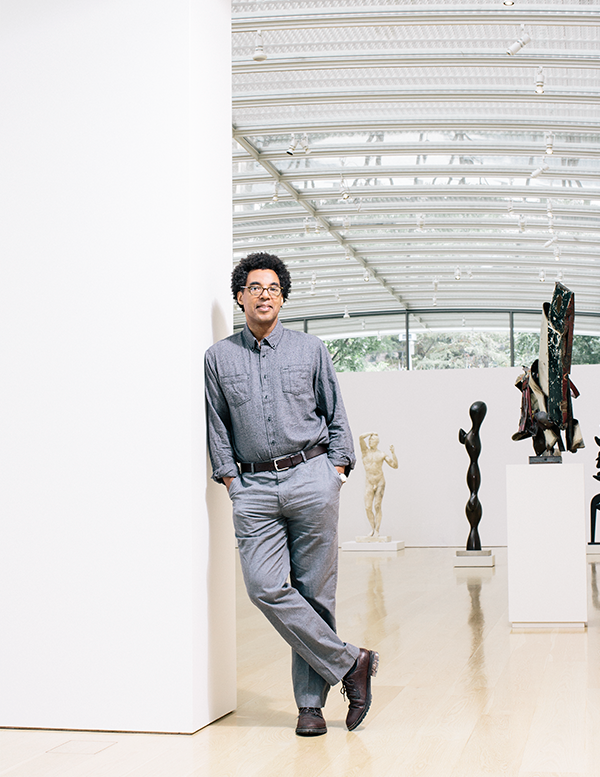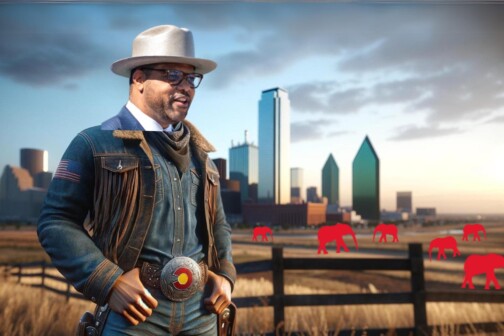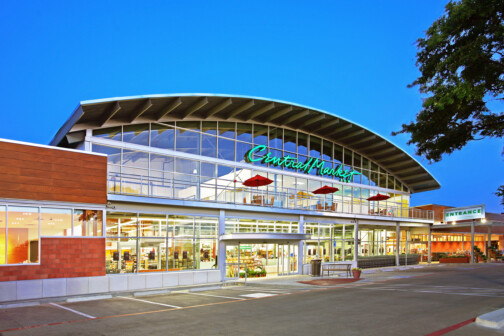As Guerrero presents the plan, Lowe sits back in his chair and listens. Afterward, he lets the rest of the group toss around ideas. People like markets, but how do we find people who can make or teach? How do we design something in the community that will show it in a different way, make the dynamics shift?
Soon the conversation turns to some of the issues the team has encountered since moving into the apartments. The air conditioning doesn’t work, the front door is broken and doesn’t feel secure, and the landlord’s promised renovations of the second apartment, the residence, are running weeks behind schedule. One of the volunteers, Michelle Wood, explains that the negligent landlords prey on the refugee community, which is reclusive and tentative.
“Here, we are bumping up against the reality of the context in which we are working,” Lowe says. “We put ourselves in a position that feels the same way the people in the neighborhood feel. How do we take that experience and turn it into something reflective and supportive?”
Mokuria, the Trans.lation project manager, suggests waging a campaign for tenants’ rights. Sam England, an artist volunteer, offers to fix the apartment front door himself. Mokuria says some of the neighbors have told her that they have an eye on the team’s apartments, watching for burglars. There are also concerns about potential fires and flooding, which could destroy the work the residents have been making for the market and storing in the apartment.

As the conversation winds and scatters, I begin to wonder about Lowe’s light-handed, democratic approach to organizing what is, at the end of the day, his public art project. At this point, Trans.lation could go in any number of directions. The team has successfully engaged the community, and its presence is already starting to create conversations—and frictions. The idea for the market is starting to feel like a secondary function of the work, an organizational excuse to live there and, as Lowe described it, put themselves in the position to feel how people in the neighborhood feel.
After allowing the conversation to wander for a while, Lowe finally takes the floor. And for the first time since I’ve been with the Trans.lation team, the artist takes control. He talks about the Nasher and he talks about art.
“I have to walk a line between the community and the Nasher,” he says. “I have to make sure that this is the kind of thing that they feel good about, contextualize it.”
He leans forward and continues: “Now, for some of you, bear with me, this is art-world speak,” he says. “Who here has heard of White Cube, a gallery in London?”
A few hands go up, and all eyes are on Lowe. White Cube, Lowe explains, is one of the most famous galleries in the world. If, as an artist, you show your work in White Cube, then you’ve made it. What Lowe doesn’t mention is that White Cube is emblematic of the consumptive glut of the contemporary art world. It has been accused of misreporting its inventory to manipulate market prices of its artists’ work.
“So I want to play with that idea, of the White Cube,” he says.
Lowe’s idea for the market is similar to Guerrero’s, but with a subtle shift that makes all the difference. He will have three white cubes constructed and installed in three parking lots along Ridgecrest. The cubes will function as galleries, displaying artists’ work in the interiors, with the residents setting up their tables and booths between them.
Lowe’s idea turns a familiar artistic strategy on its head. Ever since the French Dadaist artist Marcel Duchamp placed a urinal in a gallery and declared it art, artists have been pushing the definition of art by bringing objects from everyday life and placing them in the rarefied confines of the gallery space. But here, Lowe has proposed taking the whole gallery and placing its pristine, white walls in the context of everyday life in Vickery Meadow. The cubes, then, will take up a practical, symbolic, and metaphoric function. They will organize the market space, demarcate the area of Ridgecrest as the site of the monthly markets, and they will help attract curious art lovers who want to see Lowe’s Nasher project, thus luring them into the neighborhood even when the market isn’t happening. Perhaps more interestingly, the cubes represent a strikingly egalitarian gesture, literally bringing the art world to the people and handing it over to them.
•••
When I show up at the apartments again on a random evening in late August, three young Hispanic girls are working alongside an older Arab woman on some craft projects. Darryl Ratcliff, a member of the Trans.lation steering committee, explains that one of the bedrooms in the apartment next door has been taken over by members of a nearby condominium homeowners association that is holding a secret meeting to discuss ousting its president, who some members suspect is embezzling dues. Lowe’s idea for a common space in the community has turned into a kind of no-man’s-land; somehow teaching kids arts and crafts has also given license to a local HOA to use the space to organize a coup.
I walk outside with Ratcliff and ask him about the cubes. Lowe has tasked Ratcliff with choosing the artists for the spaces, and I wonder if Alwan’s work will be featured in one of them.
“Yes, but I don’t want it to be, ‘Oh that’s cute. They have art in Vickery Meadow,’ ” he says. “My goal is to make it so that you can be anyone and want to exhibit in this gallery. I think it is important to set the tone with an exhibition from someone who can easily get push back from the art community.”
Ratcliff also has his mind on other things, like what to do when the Nasher’s program finishes in February 2014. The landlords of the participating apartment communities are allowing the cubes to remain, so the program could continue. After all, what’s the point of all these months of community organizing if, once Lowe and the Nasher leave, the market evaporates? Earlier in the day, Ratcliff met with an administrator of the Vickery Meadow Public Improvement District to see if there might be funds for Trans.lation. Currently, most of the Vickery Meadow PID dollars go to funding extra police patrols.
The issue of financing draws into question another complicated aspect of Lowe’s work. What he creates are not autonomous artistic objects, but rather organizations that look very much like regular nonprofit groups. And these kinds of organizations need funds to survive. Even with Project Row Houses, Lowe has strived (unsuccessfully) to distance himself, to cede control of the project to volunteers from the neighborhood so that the founder is no longer essential to its sustainability. Perhaps that explains an aspect of Lowe’s light touch in Dallas, his awareness that he needs to create space for people like Ratcliff, Guerrero, and Mokuria to step in and take ownership of the project.
This tension between authorship and sustainability is a key component of much of the work that can be lumped under “art as social practice.” There is the artist’s vision, and then there is his effort to use that vision to cultivate agency in others so that he can eventually cede ownership of the work. This creative generosity seems central to what distinguishes these practices as art. It is an effort to create something that is both ego-less and uncommodifiable.
It’s hot outside, so I ask Ratcliff to see the apartment residence. In the front room, paintings cover some of the walls, mostly watercolor landscapes by Alwan’s students. But over the fireplace hangs a portrait by Alwan. It’s a man in a gray blazer, with a white button-down shirt, thick-rimmed eyeglasses, black eyebrows, and frizzy hair that sticks up in a short Afro. Set against a gray-toned background, the muted, stoic portrait is painted in the style of a picture you might see hanging on the walls of a home in Iraq. It could be the picture of a relative, a politician, or maybe a revered imam. And yet, in this context, it would be impossible to mistake the man in the portrait for anyone other than Rick Lowe. His face wears a strained, almost goofy grin. The eyes look outward, engaging the viewer. It’s a steady and unceasing gaze, and when you stare back, there is a trace of sadness in it.
Seeing the picture there above the fireplace feels both odd and full-meaning. It is an image of the artist from Houston who has parachuted into this Dallas neighborhood bearing jobs, ideas, companionship, and hope. It is a picture that seems to embody a conflicted collision of sensibilities, between an artist from the East and one from the West, between the way a refugee from Iraq who has lost his country and career honors a man he has come to love, and the way the man in the picture understands honor as a kind of disappearance from public view. The portrait encapsulates something about the project that the Trans.lation market will never bring to bear: what Rick Lowe, the person, has come to mean to the people he has gathered around him, and how essential he is to all of it.
When we walk outside, I see Alwan, who has stepped away from his students for a cigarette. I ask him why he decided to paint Lowe’s portrait. Alwan brushes off the question with nonchalance.
“Oh, that,” he says. “It’s nothing. It was easy. It’s what I do.”







